文学名词解释
古代文学名词解释

古代文学名词解释1、楚辞:“楚辞”又称“楚词”,是战国时代的伟大诗人屈原创造的一种诗体。
作用楚地(今两湖一带)的文学样式、方言声韵,叙写楚地的山川人物、历史风情,具有浓厚的地方特色。
汉代时,刘向把屈原的作品及宋玉等人“承袭屈赋”的作品编辑成集,名为《楚辞》。
楚辞,其本义是指楚地的言辞,后来逐渐固定为两种含义:一是诗歌的体裁,一是诗歌总集的名称(在一定程度上也代表了楚国文学)。
从诗歌体裁来说,它是战国后期以屈原为代表的诗人,在楚国民歌基础上开创的一种新诗体。
从总集名称来说,它是西汉刘向在前人基础上辑录的一部“楚辞”体的诗歌总集,收入战国楚人屈原、宋玉的作品以及汉代贾谊、淮南小山、庄忌、东方朔、王褒、刘向诸人的仿骚作品。
2、汉乐府:两汉乐府是指由朝廷乐府系统或相当于乐府职能的音乐管理机关搜集、保存而流传下来的汉代诗歌。
汉乐府掌管的诗歌按作用主要分为两部分,一部分是供执政者祭祀祖先神明使用的效庙歌辞,其性质与《诗经》中“颂”相同;另一部分则是采集民间流传的无主名的俗乐,世称之为乐府民歌。
乐府是自秦代以来设立的配置乐曲、训练乐工和采集民歌的专门官署,汉乐府指由汉时乐府机关所采制的诗歌。
这些诗,原本在民间流传,经由乐府保存下来,汉人叫做“歌诗”,魏晋时始称“乐府”或“汉乐府”。
后世文人仿此形式所作的诗,亦称“乐府诗”。
3、史记:《史记》是由司马迁撰写的中国第一部纪传体通史。
《史记》最初没有固定书名,或称“太史公书”,或称“太史公传”,也省称“太史公”。
“史记”本是古代史书通称,从三国时期开始,“史记”由史书的通称逐渐成为“太史公书”的专称。
记载了上自上古传说中的黄帝时代,下至汉武帝元狩元年间共3000多年的历史(哲学、政治、经济、军事等)。
《史记》与后来的《汉书》(班固)、《后汉书》(范晔、司马彪)、《三国志》(陈寿)合称“前四史”。
刘向等人认为此书“善序事理,辩而不华,质而不俚”。
与司马光的《资治通鉴》并称“史学双璧”。
文学史名词解释120个

⽂学史名词解释120个⽂学史名词解释120个-英汉对照-按字母排列1.Allegory (寓⾔)A tale in verse or prose in which characters, actions, or settings represent abstract ideas or moral qualities.寓⾔,讽喻:⼀种⽂学、戏剧或绘画的艺术⼿法,其中⼈物和事件代表抽象的观点、原则或⽀配⼒。
2.Alliteration (头韵)Alliteration is the repetition of the same initial consonant sound within a line or a group of words.头韵:在⼀组词的开头或重读⾳节中对相同辅⾳或不同元⾳的重复。
3.Allusion (典故)A reference to a person, a place, an event, or a literary work that a writer expects the reader to recognize and respond to.典故:作者对某些读者熟悉并能够作出反映的特定⼈物,地点,事件,⽂学作品的引⽤。
4.Analogy (类⽐)A comparison made between two things to show the similarities between them.类⽐:为了在两个事物之间找出差别⽽进⾏的⽐较。
5. Antagonist (反⾯主⾓)The principal character in opposition to the protagonist or hero or heroine of a narrative or drama.反⾯主⾓:叙事⽂学或戏剧中与男⼥主⼈公或英雄相对⽴的主要⼈物。
6. Antithesis (对仗)The balancing of two contrasting ideas, words, or sentences.对仗:两组相对的思想,⾔辞,词句的平衡。
文学理论名词解释大全
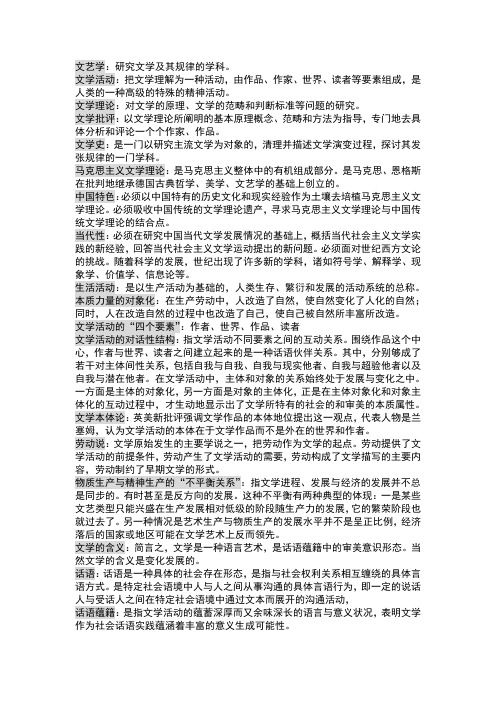
文艺学:研究文学及其规律的学科。
文学活动:把文学理解为一种活动,由作品、作家、世界、读者等要素组成,是人类的一种高级的特殊的精神活动。
文学理论:对文学的原理、文学的范畴和判断标准等问题的研究。
文学批评:以文学理论所阐明的基本原理概念、范畴和方法为指导,专门地去具体分析和评论一个个作家、作品。
文学史:是一门以研究主流文学为对象的,清理并描述文学演变过程,探讨其发张规律的一门学科。
马克思主义文学理论:是马克思主义整体中的有机组成部分。
是马克思、恩格斯在批判地继承德国古典哲学、美学、文艺学的基础上创立的。
中国特色:必须以中国特有的历史文化和现实经验作为土壤去培植马克思主义文学理论。
必须吸收中国传统的文学理论遗产,寻求马克思主义文学理论与中国传统文学理论的结合点。
当代性:必须在研究中国当代文学发展情况的基础上,概括当代社会主义文学实践的新经验,回答当代社会主义文学运动提出的新问题。
必须面对世纪西方文论的挑战。
随着科学的发展,世纪出现了许多新的学科,诸如符号学、解释学、现象学、价值学、信息论等。
生活活动:是以生产活动为基础的,人类生存、繁衍和发展的活动系统的总称。
本质力量的对象化:在生产劳动中,人改造了自然,使自然变化了人化的自然;同时,人在改造自然的过程中也改造了自己,使自己被自然所丰富所改造。
文学活动的“四个要素”:作者、世界、作品、读者文学活动的对话性结构:指文学活动不同要素之间的互动关系。
围绕作品这个中心,作者与世界、读者之间建立起来的是一种话语伙伴关系。
其中,分别够成了若干对主体间性关系,包括自我与自我、自我与现实他者、自我与超验他者以及自我与潜在他者。
在文学活动中,主体和对象的关系始终处于发展与变化之中。
一方面是主体的对象化,另一方面是对象的主体化,正是在主体对象化和对象主体化的互动过程中,才生动地显示出了文学所特有的社会的和审美的本质属性。
文学本体论:英美新批评强调文学作品的本体地位提出这一观点,代表人物是兰塞姆,认为文学活动的本体在于文学作品而不是外在的世界和作者。
文学名词解释

名词解释1,三言:《三言》是明代作家冯梦龙编撰的三部拟话本小说集的总称,包括《喻世明言》《警世通言》《醒世恒言》。
它们主要描写的是市民生活的生动画面,即将普通市民及其生活作为自己的主要表现对象。
主要表现的思想有:对“重农抑商”传统观念的反动;以个性自由为基础的爱情观念;市民眼中的社会黑暗面。
艺术上追求“雅俗共赏”。
2.一、人、永、占:李玉的四部戏曲作品的省称,包括《一捧雪》、《人兽关》、《永团圆》、《占花魁》。
《一捧雪》写明代“伪画致祸”的故事。
《人兽关》写人与人之间的金钱关系。
《永团圆》讽刺势利的小人。
《占花魁》反映了作者的庸俗思想。
四部作品是李玉的代表作。
3.常州词派;(1)清中期以张惠言为代表的词派;(2)强调比兴寄托;(3)提倡“深美闳约”的词风。
4.“荆、刘、拜、杀”:指《荆钗记》、《白兔记》、《拜月亭》、《杀狗记》四大南戏。
它们为南戏的代表作。
5.二拍;《二拍》是明代作家凌濛初拟话本小说集《拍案惊奇》和《二刻拍案惊奇》的合称。
其内容大致包括:经商题材的时代特色;爱情题材的新突破;超前的社会批判精神。
《二拍》的出现是拟话本小说在体制上定型的标志。
《二拍》中对人物性格刻画的考究,对细节真实的追求,都表现出文人个人创作的鲜明文学6.南戏:(1)又称南曲戏文,原是宋以来南方浙、闽一带用村坊小曲演唱的民间小戏。
(2)它在形成和发展过程中吸收了大曲、清官调、滑稽戏等民间说唱技艺,以及宋杂剧表演故事的形式,故开始时又叫“永嘉杂剧”或“温州杂剧”。
(3)元灭南宋后,它的故事题材和演唱艺术又受到北杂剧的影响,并逐渐成为一种较为成熟的戏剧样式。
1.简答题1.简述曲的诗体特性。
第一,灵活多变伸缩自如的句式。
第二、以俗为尚和口语化、散文化的语言风格;第三、明快显豁自然酣畅的审美取向。
2.简析纳兰性德词与陈维崧、朱彝尊词的不同(1)陈维崧师法苏轼、辛弃疾的豪放词,往往以豪情抒发悲慨;(2)朱彝尊师法姜夔、张炎,崇尚醇雅清空,注重词的格律、声韵、技巧;(3)纳兰词风格既不豪壮,也非清空,而是哀郁凄婉;艺术表现自然流转,婉丽清新,没有刻意雕琢;善用白描手法。
文学概论名词解释
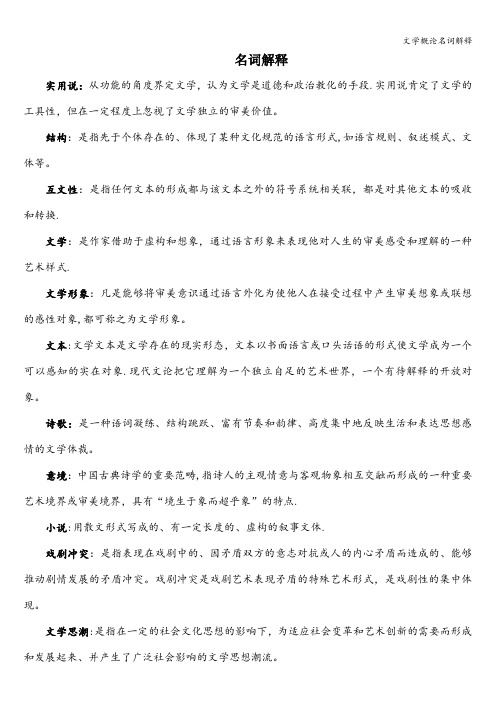
名词解释实用说:从功能的角度界定文学,认为文学是道德和政治教化的手段.实用说肯定了文学的工具性,但在一定程度上忽视了文学独立的审美价值。
结构:是指先于个体存在的、体现了某种文化规范的语言形式,如语言规则、叙述模式、文体等。
互文性:是指任何文本的形成都与该文本之外的符号系统相关联,都是对其他文本的吸收和转换.文学:是作家借助于虚构和想象,通过语言形象来表现他对人生的审美感受和理解的一种艺术样式.文学形象:凡是能够将审美意识通过语言外化为使他人在接受过程中产生审美想象或联想的感性对象,都可称之为文学形象。
文本:文学文本是文学存在的现实形态,文本以书面语言或口头话语的形式使文学成为一个可以感知的实在对象.现代文论把它理解为一个独立自足的艺术世界,一个有待解释的开放对象。
诗歌:是一种语词凝练、结构跳跃、富有节奏和韵律、高度集中地反映生活和表达思想感情的文学体裁。
意境:中国古典诗学的重要范畴,指诗人的主观情意与客观物象相互交融而形成的一种重要艺术境界或审美境界,具有“境生于象而超乎象”的特点.小说:用散文形式写成的、有一定长度的、虚构的叙事文体.戏剧冲突:是指表现在戏剧中的、因矛盾双方的意志对抗或人的内心矛盾而造成的、能够推动剧情发展的矛盾冲突。
戏剧冲突是戏剧艺术表现矛盾的特殊艺术形式,是戏剧性的集中体现。
文学思潮:是指在一定的社会文化思想的影响下,为适应社会变革和艺术创新的需要而形成和发展起来、并产生了广泛社会影响的文学思想潮流。
文学流派:是指一批作家因为在思想倾向和文学观念上有相近的见解,在创作实践上有共同的艺术追求,并以他们的创作实绩显示了相似的风格特色而形成的创作群体。
典型:即典型人物或典型性格,是现实主义叙事文学所创造的、在整体个性的表现中显示了某种社会历史蕴意的、具有高度审美价值的人物形象或人物性格。
浪漫主义:是一种以充满激情的艺术形象来表现理想追求、主观情感和某种社会心理的文学类型。
自然主义:是19世纪后期以左拉为代表的一种文学思潮,它是对于现实主义文学理论的一种片面、扭曲的延续和发展,主张以自然科学方法来观察和表现社会人生。
文学理论名词解释
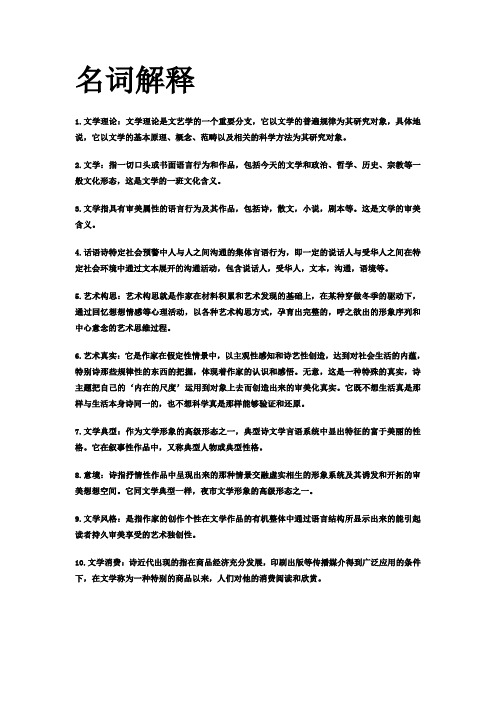
名词解释1.文学理论:文学理论是文艺学的一个重要分支,它以文学的普遍规律为其研究对象,具体地说,它以文学的基本原理、概念、范畴以及相关的科学方法为其研究对象。
2.文学:指一切口头或书面语言行为和作品,包括今天的文学和政治、哲学、历史、宗教等一般文化形态,这是文学的一班文化含义。
3.文学指具有审美属性的语言行为及其作品,包括诗,散文,小说,剧本等。
这是文学的审美含义。
4.话语诗特定社会预警中人与人之间沟通的集体言语行为,即一定的说话人与受华人之间在特定社会环境中通过文本展开的沟通活动,包含说话人,受华人,文本,沟通,语境等。
5.艺术构思:艺术构思就是作家在材料积累和艺术发现的基础上,在某种穿做冬季的驱动下,通过回忆想想情感等心理活动,以各种艺术构思方式,孕育出完整的,呼之欲出的形象序列和中心意念的艺术思维过程。
6.艺术真实:它是作家在假定性情景中,以主观性感知和诗艺性创造,达到对社会生活的内蕴,特别诗那些规律性的东西的把握,体现着作家的认识和感悟。
无意,这是一种特殊的真实,诗主题把自己的‘内在的尺度’运用到对象上去而创造出来的审美化真实。
它既不想生活真是那样与生活本身诗同一的,也不想科学真是那样能够验证和还原。
7.文学典型:作为文学形象的高级形态之一,典型诗文学言语系统中显出特征的富于美丽的性格。
它在叙事性作品中,又称典型人物或典型性格。
8.意境:诗指抒情性作品中呈现出来的那种情景交融虚实相生的形象系统及其诱发和开拓的审美想想空间。
它同文学典型一样,夜市文学形象的高级形态之一。
9.文学风格:是指作家的创作个性在文学作品的有机整体中通过语言结构所显示出来的能引起读者持久审美享受的艺术独创性。
10.文学消费:诗近代出现的指在商品经济充分发展,印刷出版等传播媒介得到广泛应用的条件下,在文学称为一种特别的商品以来,人们对他的消费阅读和欣赏。
11.期待视野:在文学阅读之先及阅读过程中,作为主题的读者,基于个人与社会的复杂原因,心理上往往会有集成的思维之象与观念结构。
中国古代文学名词解释
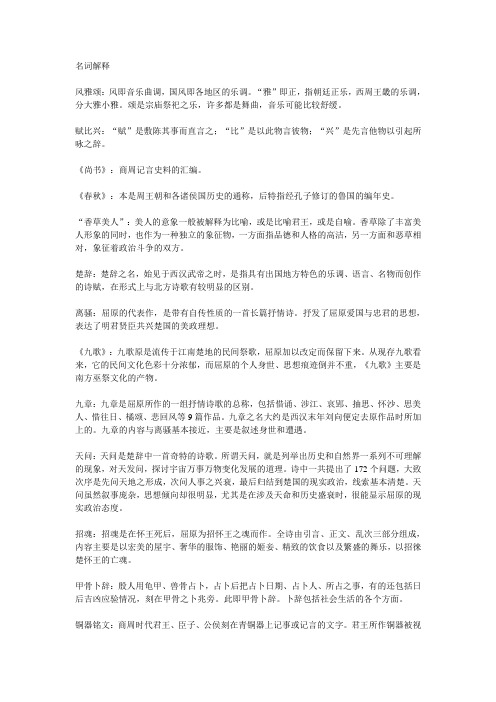
名词解释风雅颂:风即音乐曲调,国风即各地区的乐调。
“雅”即正,指朝廷正乐,西周王畿的乐调,分大雅小雅。
颂是宗庙祭祀之乐,许多都是舞曲,音乐可能比较舒缓。
赋比兴:“赋”是敷陈其事而直言之;“比”是以此物言彼物;“兴”是先言他物以引起所咏之辞。
《尚书》:商周记言史料的汇编。
《春秋》:本是周王朝和各诸侯国历史的通称,后特指经孔子修订的鲁国的编年史。
“香草美人”:美人的意象一般被解释为比喻,或是比喻君王,或是自喻。
香草除了丰富美人形象的同时,也作为一种独立的象征物,一方面指品德和人格的高洁,另一方面和恶草相对,象征着政治斗争的双方。
楚辞:楚辞之名,始见于西汉武帝之时,是指具有出国地方特色的乐调、语言、名物而创作的诗赋,在形式上与北方诗歌有较明显的区别。
离骚:屈原的代表作,是带有自传性质的一首长篇抒情诗。
抒发了屈原爱国与忠君的思想,表达了明君贤臣共兴楚国的美政理想。
《九歌》:九歌原是流传于江南楚地的民间祭歌,屈原加以改定而保留下来。
从现存九歌看来,它的民间文化色彩十分浓郁,而屈原的个人身世、思想痕迹倒并不重,《九歌》主要是南方巫祭文化的产物。
九章:九章是屈原所作的一组抒情诗歌的总称,包括惜诵、涉江、哀郢、抽思、怀沙、思美人、惜往日、橘颂、悲回风等9篇作品。
九章之名大约是西汉末年刘向便定去原作品时所加上的。
九章的内容与离骚基本接近,主要是叙述身世和遭遇。
天问:天问是楚辞中一首奇特的诗歌。
所谓天问,就是列举出历史和自然界一系列不可理解的现象,对天发问,探讨宇宙万事万物变化发展的道理。
诗中一共提出了172个问题,大致次序是先问天地之形成,次问人事之兴衰,最后归结到楚国的现实政治,线索基本清楚。
天问虽然叙事庞杂,思想倾向却很明显,尤其是在涉及天命和历史盛衰时,很能显示屈原的现实政治态度。
招魂:招魂是在怀王死后,屈原为招怀王之魂而作。
全诗由引言、正文、乱次三部分组成,内容主要是以宏美的屋宇、奢华的服饰、艳丽的姬妾、精致的饮食以及繁盛的舞乐,以招徕楚怀王的亡魂。
文学概念名词解释
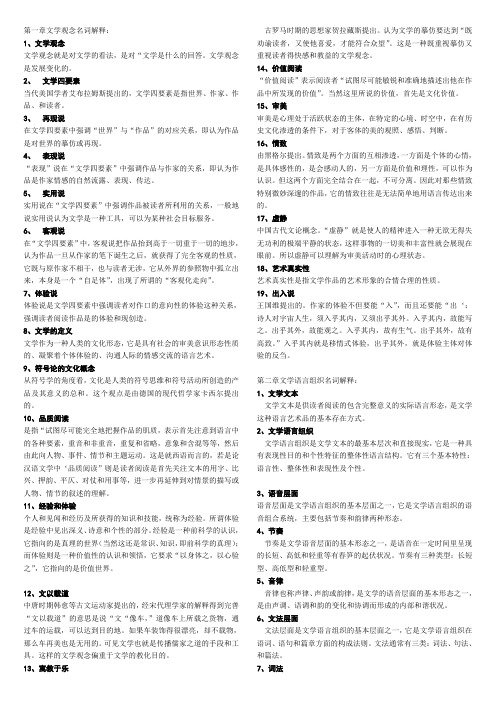
第一章文学观念名词解释:1、文学观念文学观念就是对文学的看法,是对“文学是什么的回答。
文学观念是发展变化的。
2、文学四要素当代美国学者艾布拉姆斯提出的,文学四要素是指世界、作家、作品、和读者。
3、再现说在文学四要素中强调“世界”与“作品”的对应关系,即认为作品是对世界的摹仿或再现。
4、表现说“表现”说在“文学四要素”中强调作品与作家的关系,即认为作品是作家情感的自然流露、表现、传达。
5、实用说实用说在“文学四要素”中强调作品被读者所利用的关系,一般地说实用说认为文学是一种工具,可以为某种社会目标服务。
6、客观说在“文学四要素”中,客观说把作品抬到高于一切重于一切的地步,认为作品一旦从作家的笔下诞生之后,就获得了完全客观的性质,它既与原作家不相干,也与读者无涉,它从外界的参照物中孤立出来,本身是一个“自足体”,出现了所谓的“客观化走向”。
7、体验说体验说是文学四要素中强调读者对作口的意向性的体验这种关系,强调读者阅读作品是的体验和现创造。
8、文学的定义文学作为一种人类的文化形态,它是具有社会的审美意识形态性质的、凝聚着个体体验的、沟通人际的情感交流的语言艺术。
9、符号论的文化概念从符号学的角度看,文化是人类的符号思维和符号活动所创造的产品及其意义的总和。
这个观点是由德国的现代哲学家卡西尔提出的。
10、品质阅读是指“试图尽可能完全地把握作品的肌质,表示首先注意到语言中的各种要素,重音和非重音,重复和省略,意象和含混等等,然后由此向人物、事件、情节和主题运动。
这是就西语而言的,若是论汉语文学中‘品质阅读”则是读者阅读是首先关注文本的用字、比兴、押韵、平仄、对仗和用事等,进一步再延伸到对情景的描写或人物、情节的叙述的理解。
11、经验和体验个人和见闻和经历及所获得的知识和技能,统称为经验。
所谓体验是经验中见出深义、诗意和个性的部分。
经验是一种前科学的认识,它指向的是真理的世界(当然这还是常识、知识,即前科学的真理);而体验则是一种价值性的认识和领悟,它要求“以身体之,以心验之”,它指向的是价值世界。
- 1、下载文档前请自行甄别文档内容的完整性,平台不提供额外的编辑、内容补充、找答案等附加服务。
- 2、"仅部分预览"的文档,不可在线预览部分如存在完整性等问题,可反馈申请退款(可完整预览的文档不适用该条件!)。
- 3、如文档侵犯您的权益,请联系客服反馈,我们会尽快为您处理(人工客服工作时间:9:00-18:30)。
1、Modernism(现代主义)1)Modernism was a complex and diverse international movement in all creative arts, originating about the end of the 19th century、2)rising out of skepticism and disillusionment of capitalism, which made writers andartists search for new ways to express their understanding of the world and the human nature、The French Symbolism, appearing in the late, 19th century, became the forerunner of modernism、3)It provided the greatest renaissance of the 20th century、4)It means a departure from the conventional criteria or established values of the Victorian age、It took the irrational philosophy and theory of psychoa/nalysis as its theoretical base、5)Major themes: the distorted, alienated and ill relationships between man and nature, man and society, man and man, man and himself、6) It was made up of many facets, such as symbolism, surrealism, stream of consciousness , expressionism, futurism, etc、Alienation and loneliness are the basic themes of modernism、Modernism also touched upon visual arts, music, dance andthe other fields of social life、7)The major figures that were associated with this movement were Kafka, Picasso, Pound, Eliot, Joyce and Virginia Woolf, etc、2、Streams of consciousness (意识流)(1)is a term to describe the flow of thoughts of the waking mind、(2)Now it is widely used to describe the unspoken thoughts and feelings of the characters, without resorting to objective description or conventional dialogue、(3)It was adapted and developed by Joyce, Virginia Woolf, and others、(4)The ability to represent the flux of a character’s thought, impressions, emotions, or reminiscences, often without logical sequence or syntax, marked a revolution in theform of novel at that time、(5)The order of our study must be analytic、(6)It begins the introspective study of the adult consciousness itself、3、Renaissance (文艺复兴)A、 a great bourgeois cultural movement in Europe, which began in the 14th centuryand continued to the mid-17th century、B、It first started in Italy, with the flowering of painting, sculpture and literature andthen spread all over Europe、、C、the term means “rebirth” or “revival”D、Humanism is the essence of the renaissance、E、representatives: Dante, Christopher Marlowe and William ShakespeareF、It marked the beginning of bourgeois revolution4、Humanism(人文主义)A、it is a system of beliefs upheld by writers and artists of the renaissance period intheir fighting against medieval a/sceticism禁欲主义、B、It states that man is able to find truth, goodness a nd beauty, and that man is in control of the present life rather than being controlled by God、C、Briefly, humanism puts man at the center of their beliefs and takes man to be themeasure of everythingD、They introduce new ideas, call for man’s freedom in thinking, praise man’s w aspirations渴望, and de/nunciate (公开谴责)the feuda/listic control of man’sthought、E、In England, Thomas More, Christopher Marlowe and William Shakespeare are thebest representatives of the English humanists、F、it is the essence of the Renaissance Period、5、Gothic Novel(哥特式小说)1)It is a type of romantic fiction that predominated in the late 18th century2)Its principal elements are violence, horror, and the supernatural、3)Mostly stories of mystery and horror took place in some haunted or dilapidated/deserted Middle Age castles、4) gothic heroes and heroines tend to the equally mysterious, emphasis on theirrational and dark side of human nature: the imaginative, the supernatural, thediscarded Medieval castles against the rigid rationality principle、5) They emphasize story line and setting over character and characterization6) Representatives: Horace Walpole–The Castle of Otranto;Ann Radcliff---- TheMysteries of Udolpho6、Realism(现实主义)1)Realism is the determination to face facts and deal with them practically, withoutbeing influenced by feelings or false ideas、2)In literature, realism is a way of writing about people and events as they actuallyare、3)in art, an attempt to describe human behavior and surroundings or to representfigures and objects exactly as they act or appear in life、4) Representative writers: Daniel Defoe; Joanthan Swift; Henry Fielding, etc、7、Enlightment:The Enlightment movement(1),it was a progressive philosophical and artistic movement which flourished infrance and swept through western Europe in the 18th century、(2)the movement was afurtherance of the Renaissance f rom 14th century to the mid-17th century、(3)itspurpose was to enlighten the whole world with the light of modern philosophical and artisticideas、(4)they believed that reason or rationality become standards for measurement ofeverything、(5)they held the common faith in human rationality and the possibility of humanperfection through education、(6)representatives:Alexander Pope, Richard Steele,8,Critical Realism批判现实主义It is the main trend of the literary thoughts in the 19th century、It reveals the corrupting influenceof the rule of cash upon human nature、Critical realists criticize capitalist society from ademocratic viewpoint of bourgeoisie reality、The major contribution made by the 19th centurycritical realists lies in their perfection of novels、They make use of the from of novel for full anddetailed representations of social and political events, and of the fate of individuals and of wholesocial classes、。
